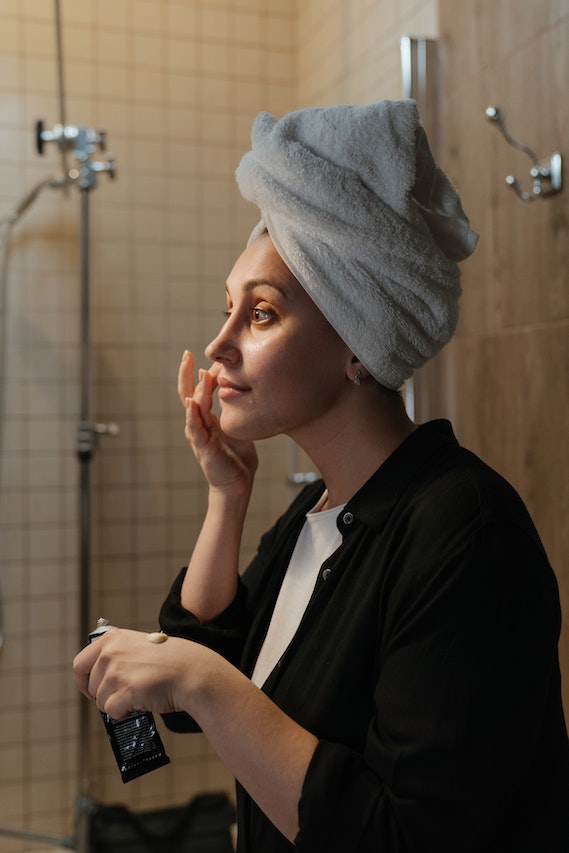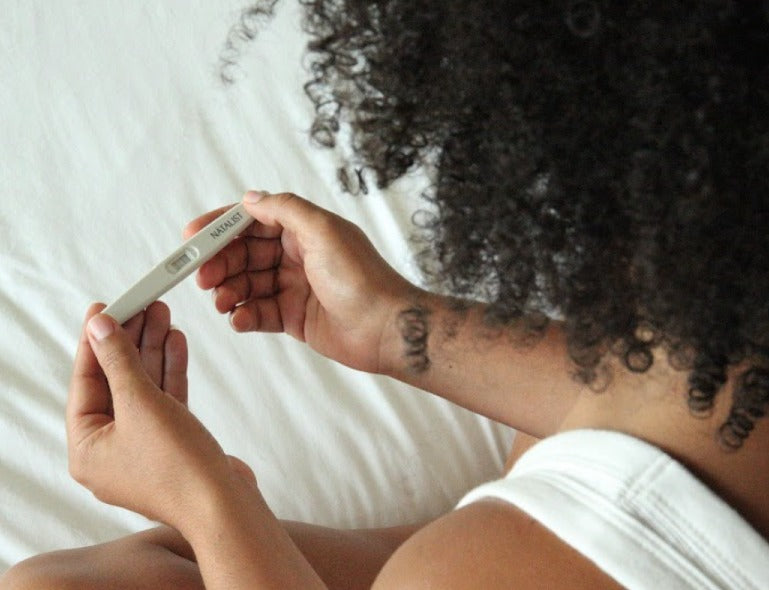Can I Get Botox® While Pregnant, TTC, or Breastfeeding?

By OBGYN and reproductive health specialist Dr. Mare Mbaye
Originally published 08/10/2022. Updated for accuracy and relevancy on 05/09/2024
Botox® is a big no-no if you’re pregnant or planning to become pregnant. Let’s get into why and for how long Botox® isn’t allowed and what alternatives there are.
Whether you already get Botox® on the regular, are planning to get it for the first time, or are just intrigued by what you’ve seen and heard about it, the question "Can I get Botox® while pregnant?" is an important one to address. Botox® is, unfortunately, a big no-no if you’re pregnant or planning to become pregnant.
Instead of just telling you NO, let’s get into why and for how long Botox® isn’t allowed and what alternatives there are. Keep reading to learn all about Botox® and pregnancy!
What Is Botox®?
Botox® is an aesthetic treatment for fine lines, skin rejuvenation, and wrinkles. It’s the most popular cosmetic procedure in the US, according to the American Board of Cosmetic Surgery. [1] Botox® itself is a neurotoxin made from the Clostridium botulinum-derived botulinum toxin. When injected into muscle, this toxin temporarily restricts muscle movement. This reduced movement causes the overlying skin of those facial muscles to fold less (or not at all) so that wrinkles are prevented and reversed. Botox® is FDA-approved for injection into crow’s feet, forehead lines, and frown lines. [1]
Of note, there is a common misconception that all aesthetic neurotoxins are Botox®, but Botox® is just the brand name. There are multiple other brands that work the same way, including Dysport, Jeauveau, and Xeomin.
Risks of Botox®
Even if you’re not pregnant or trying to conceive (TTC), there are still risks associated with Botox®. Mild redness, swelling at the Botox® injection site, and bruising are the most common side effects. [1] Other side effects include headache, fatigue, dry mouth, or more severe symptoms like vision changes or life-threatening allergic reactions. [2-3]
Benefits of Botox®
The wrinkle-reducing effects of botulinum toxin products are just one benefit. Some neurotoxins can also be used to treat conditions relating to nerve and muscle activity, like chronic migraines, urinary incontinence (leaky bladder), excessive sweating, or vertical neck bands. [1] Botulinum type A injections can interrupt the nerve impulses that activate the sweat glands, which in turn reduces excessive sweating of the armpits, hands, or feet. Botulinum toxin A can also soften prominent vertical bands on the neck by relaxing the responsible muscles, giving the neck a smoother, softer appearance. [1]
Is Botox® Safe During Pregnancy or While Breastfeeding?
While there’s technically no conclusive answer to this question, the short answer is no. Until the research shows otherwise, most experts recommend stopping Botox® once you are actively trying to get pregnant until after your baby is born
What about Botox® while breastfeeding? Sadly, it’s still a no. Researchers haven’t studied the effects of Botox® on breast milk so it’s not known with certainty if it passes into breast milk. [4] The risk is likely very small, but since we already know the botulinum toxin can spread beyond a treatment area, why take the risk of it passing to your baby through your breast milk?
Risks of Botox® While Pregnant and Breastfeeding
There are a few reasons for the medical community's caution with Botox® during pregnancy. First, Botox® has an FDA warning alerting users to the risk that the botulinum toxin can spread beyond the Botox® treatment area and affect other parts of the body with the same movement-inhibiting effects that help with wrinkles. [5]
In animal studies, rodents injected with Botox® had babies that were born early, didn’t develop properly, or even died. [6] We can't be sure that the same would happen in human babies since the research just hasn’t been done, but without any evidence proving otherwise, doctors will continue to advise against Botox® in pregnancy.
Now, what if you used Botox® before finding out you were pregnant? What are the chances the Botox® crossed to the baby? Thankfully, the same animal studies have found no evidence of the toxin from Botox® injections passing through the placental wall to harm the developing fetus. [6]
This means that if you’ve had Botox® treatment recently before becoming pregnant or before realizing you were pregnant, there’s no need to panic! The small doses of botulinum toxin that are used in a single treatment session are unlikely to make it near your baby. Just don't plan on any more Botox® treatments until you’re done with breastfeeding.
The good news is that many women who usually get Botox® don’t feel like they need it while they're pregnant. As you retain more water in pregnancy, some fine lines and wrinkles may get filled out. And there are fortunately other ways to keep your skin looking young and healthy.
Pregnancy-Safe Botox® Alternatives
Even without your trusty Botox®, there are other ways to maintain a pregnancy-safe anti-aging regimen. These alternatives are not equivalent to Botox® (otherwise, why would anyone pay for Botox®?), but they have anti-aging benefits that are safe for you and your baby during pregnancy and breastfeeding. Consider incorporating some of the following pregnancy-safe skincare ingredients into your regimen.
Glycolic Acid
Glycolic acid is known as the most effective alpha-hydroxy acid (AHA) exfoliant. [7] In addition to helping to smooth lines, it can also help improve tone and texture to potentially combat melasma during pregnancy, treat sun damage, and plump the skin. Glycolic acid is believed to stimulate collagen production in the skin. While it’s not nearly as effective for reducing wrinkles as Botox®, it can help to reduce fine lines over time.
Hyaluronic Acid
One of the main tenets of skincare has always been hydrate, hydrate, hydrate! This key step doesn’t change in pregnancy, and it can help treat and prevent dry skin during pregnancy as well as fine lines and wrinkles from developing in the first place. Learn more about the benefits of hydration during pregnancy and drinking water while breastfeeding.
Hyaluronic acid (HA) is your best friend when it comes to keeping skin hydrated and moisturized. [8] HA is a water-attracting molecule that is produced naturally in the body, and it can hold 1,000 times its weight in water. It’s also generally well-tolerated by all skin types, even people with sensitive skin. [8] HA can be found in many skincare products, from serums to lotions to creams.
An important note with HA: there are different molecular sizes that make certain products better for certain things. Smaller molecules have no trouble getting into the skin so they are great as hydrators and moisturizers on their own. Larger molecules can’t pass through the skin so they are better for sealing in moisture.
Argireline
Argireline is another pregnancy-safe Botox® alternative. It interferes with the neurotransmitters responsible for muscle movement, thereby smoothing out fine lines and wrinkles. It works similarly to Botox®, though it’s of course less effective.
Clinical trials have been promising, with one study showing that 10 percent topical Argireline reduced wrinkles by 30 percent while another showed that with twice daily use, it could be up to 48 percent effective. [9]
Facials and Facial Acupuncture
Another alternative, if it’s within your budget, is to simply pay an aesthetician and get yourself a facial. Facials are a great way to rejuvenate your skin and facial acupuncture has also recently been used as an alternative to Botox®, though the research is still early. [10]
Go on now, you deserve it. Just make sure your aesthetician or acupuncturist knows that you’re TTC, pregnant, or breastfeeding. They will adjust the skincare ingredients they use and hopefully provide you with some suggestions to take home with you.
And don’t forget about lifestyle practices for pregnancy self care that help you keep your skin looking healthy (while also keeping you and your baby healthy):
- Drink plenty of water (or hydrating drink mixes) every day.
- Eat a healthy mix of foods, including lean proteins, nuts, and lots of vegetables and fruit.
- Try to be physically active every day. Go out for walks with your baby and get other exercise when you can.
- Protect your skin from the sun.
- Get plenty of sleep. This one is tough after you’re home with a new baby. Try to nap when you can and especially when the baby is sleeping. Take turns with your partner getting up at night. Hire a sitter to give yourself a break. Get out of the house and hang out with your friends, family, or whatever support system you have.
Talk With Your Doctor
While you’ll have to put a hold on those Botox® appointments for a while, there are thankfully plenty of pregnancy-safe Botox® alternatives to try to include into your skincare regimen. You can keep your baby safe AND still keep your skin looking beautiful.
And when in doubt, always speak with your healthcare provider or dermatologist about other options that may be right for you while TTC, pregnant, or breastfeeding.
If you’re someone who uses Botox® for reasons other than cosmetics, such as migraines, muscle spasms, or bladder leaks, stopping Botox® will involve a bigger conversation with your healthcare provider. They will help guide your decision-making about alternative options that can safely treat your condition while you’re pregnant and breastfeeding.
Support Your Pregnancy With Natalist
There are a lot of things to remember when it comes to maintaining a healthy pregnancy. From the right diet to knowing the warning signs of potential complications, it’s easy to feel overwhelmed. At Natalist, we strive to provide accurate, easy-to-digest information and evidence-based products that can make your TTC, pregancy, and postpartum journies easier. Shop our curated products, or keep reading on the Natalist blog.
References:
- BOTOX-TYPE INJECTABLES GUIDE. American Board of Cosmetic Surgery. Accessed September 2023. Medical citation URL.
- Botox Label. FDA. Revised 08/2011. Medical Citation URL.
- Botox Cosmetic FAQ. AbbVie. Accessed September 2023. Medical Citation URL.
- Drugs and Lactation Database (LactMed®) [Internet]. Bethesda (MD): National Institute of Child Health and Human Development; 2006-. Botulin A. [Updated 2020 Sep 21]. Medical Citation URL.
- Botox Cosmetic FAQ. AbbVie. Accessed September 2023. Medical Citation URL.
- Jose M, Sreelatha HV, James MV, Arumughan S, Thomas SV. Teratogenic Effects of Carbamazepine in Mice. Ann Indian Acad Neurol. 2017;20(2):132-137. doi:10.4103/aian.AIAN_492_16.
- National Center for Biotechnology Information. PubChem Compound Summary for CID 757, Glycolic Acid. Medical Citation URL. Accessed Sept. 29, 2023.
- Papakonstantinou E, Roth M, Karakiulakis G. Hyaluronic acid: A key molecule in skin aging. Dermatoendocrinol. 2012;4(3):253-258. doi:10.4161/derm.21923
- Argireline in Treatment of Periorbital Wrinkles. Mahidol University. 06/27/2011. Clinical Trial NCT01381484
- Yun Y, Kim S, Kim M, Kim K, Park JS, Choi I. Effect of facial cosmetic acupuncture on facial elasticity: an open-label, single-arm pilot study. Evid Based Complement Alternat Med. 2013;2013:424313. doi:10.1155/2013/424313
Reach Out, We're Here
Have questions about your order or products? For the speediest answer, check out our FAQ section. Need something else? Come find us below.
Please keep in mind our regular business hours; Monday-Friday, 9am-5pm CT.
Customer Support
support@natalist.com
Press Inquiries
media@everlyhealth.com
Business & Partnerships
team@natalist.com
Affiliates + Influencers
team@natalist.com
Job Openings
Careers Page

























